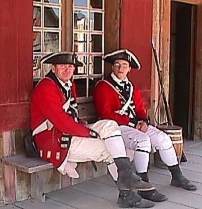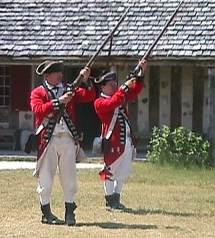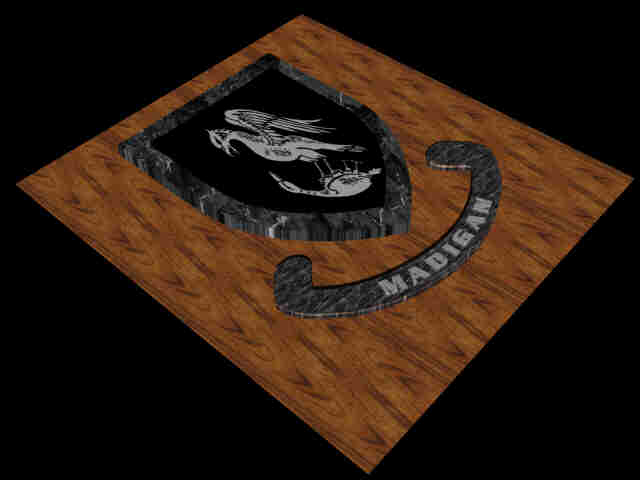The Fort, which is now a
State Park, has its entrance under the famous Mackinac Bridge.
Here we found the access to a path which led westward for several
hundred yards to the Fort. The Fort is a reconstruction, made as
it was originally, entirely of wood. Each building erected was
the result of painstaking archaeological investigations in the
ground and in the records so carefully kept by the commandant and
merchants who lived there so long ago. As we wandered the
grounds, there  were many things of interest to be discovered.
Several displays described the women who filled many economic
roles vital to the fur trade. Odawa and Ojibwa women grew corn
and traded to local merchants. French Canadian or Metis (people
of Indian and European parentage) women worked in the trade as
interpreters or traders. British women arrived with the military
or traders. Enlisted men's wives often were employed as
laundresses or domestic servants. It is known that Indians slaves
arrived from the western tribes, were captured and sold into
slavery by other Indians. These people were called panis, a
Pawnee word, as the Pawnee Indians were the frequent source of
slaves. The slave population at
were many things of interest to be discovered.
Several displays described the women who filled many economic
roles vital to the fur trade. Odawa and Ojibwa women grew corn
and traded to local merchants. French Canadian or Metis (people
of Indian and European parentage) women worked in the trade as
interpreters or traders. British women arrived with the military
or traders. Enlisted men's wives often were employed as
laundresses or domestic servants. It is known that Indians slaves
arrived from the western tribes, were captured and sold into
slavery by other Indians. These people were called panis, a
Pawnee word, as the Pawnee Indians were the frequent source of
slaves. The slave population at  Michilimackinac included African-American woman
and men. The panis woman left little evidence of her life in the
archaeological and historical record. She probably spent her time
cooking, cleaning, washing and mending, using common European
tools. The exchange of Indian and European materials obscured
adaptations of native sewing or cooking techniques, thus
household items excavated cannot yet be correlated with ethnic
groups or gender. As a captive far from home her personal
possessions were few. Each reconstructed building at
Michilimackinac is the result of years of research archaeology
and construction. Although archaeologists have been digging since
1959, only half of the Fort's buildings have been excavated and
reconstructed. This project will take many more years to
complete.
Michilimackinac included African-American woman
and men. The panis woman left little evidence of her life in the
archaeological and historical record. She probably spent her time
cooking, cleaning, washing and mending, using common European
tools. The exchange of Indian and European materials obscured
adaptations of native sewing or cooking techniques, thus
household items excavated cannot yet be correlated with ethnic
groups or gender. As a captive far from home her personal
possessions were few. Each reconstructed building at
Michilimackinac is the result of years of research archaeology
and construction. Although archaeologists have been digging since
1959, only half of the Fort's buildings have been excavated and
reconstructed. This project will take many more years to
complete.  Undiscovered artifacts and building ruins
remained buried in the sands of Michilimackinac waiting for
archaeologists to excavate them. The British soldiers first
marched into Fort Michilimackinac in the fall of 1761 following
their victory over French and Indian forces in the "Seven
Years War" also known as the French and Indian War. For the
next 20 years these soldiers carried out British policy in the
upper Great Lakes. Many displays examine the life and times of
the ordinary British soldier in some detail. Most of
Michilimackinac's British soldiers volunteered to join the army.
They enlisted through a process known as "beating up for
volunteers." Smartly dressed drummers drew crowds with their
music while recruiting officers gave rousing speeches about the
benefits of military life. Although men enlisted for life, the
army often released soldiers when age or sickness
Undiscovered artifacts and building ruins
remained buried in the sands of Michilimackinac waiting for
archaeologists to excavate them. The British soldiers first
marched into Fort Michilimackinac in the fall of 1761 following
their victory over French and Indian forces in the "Seven
Years War" also known as the French and Indian War. For the
next 20 years these soldiers carried out British policy in the
upper Great Lakes. Many displays examine the life and times of
the ordinary British soldier in some detail. Most of
Michilimackinac's British soldiers volunteered to join the army.
They enlisted through a process known as "beating up for
volunteers." Smartly dressed drummers drew crowds with their
music while recruiting officers gave rousing speeches about the
benefits of military life. Although men enlisted for life, the
army often released soldiers when age or sickness made them
unfit for duty. Beginning in the 1750s industrial development
created dramatic changes in the British economy. Men put out of
work by these changes were assured of food clothing and shelter
by joining the army. Volunteers were offered an enlistment bounty
of 1 1/2 guineas, which equaled 50 days of pay for a soldier.
Once in, the army soldiers earned 8 pence per day. These men saw
little cash however as the military deducted 6 pence a day for
food and made adjustments for clothing, laundry and other
expenses. The daily ration of a solider in the 86th Regiment at
Michilimackinac was 1 lb. of bread, 1/2 lb. of pork, 1 oz butter,
1/4 pint of peas and 1 oz of oatmeal. Rations were issued weekly
and pooled by a group of men known as the "mess". Each
room of the barracks housed two "messes." Because
Michilimackinac was at the end of the supply line, the rations
were often of poor quality. The men frequently supplemented them
with fresh fish and local produce.
made them
unfit for duty. Beginning in the 1750s industrial development
created dramatic changes in the British economy. Men put out of
work by these changes were assured of food clothing and shelter
by joining the army. Volunteers were offered an enlistment bounty
of 1 1/2 guineas, which equaled 50 days of pay for a soldier.
Once in, the army soldiers earned 8 pence per day. These men saw
little cash however as the military deducted 6 pence a day for
food and made adjustments for clothing, laundry and other
expenses. The daily ration of a solider in the 86th Regiment at
Michilimackinac was 1 lb. of bread, 1/2 lb. of pork, 1 oz butter,
1/4 pint of peas and 1 oz of oatmeal. Rations were issued weekly
and pooled by a group of men known as the "mess". Each
room of the barracks housed two "messes." Because
Michilimackinac was at the end of the supply line, the rations
were often of poor quality. The men frequently supplemented them
with fresh fish and local produce.  With the beginning of the American Revolutionary
War, the British realized that wooden walls could not stand up to
cannon fire and moved the fort out onto Mackinac Island where
much of it was constructed of limestone. During the move, the
buildings inside the old fort were torn down and reconstructed
out on the island. The new fort would stay in British hands until
after the Revolutionary War at which time Fort Mackinac would
become an American possession but that's another story.
With the beginning of the American Revolutionary
War, the British realized that wooden walls could not stand up to
cannon fire and moved the fort out onto Mackinac Island where
much of it was constructed of limestone. During the move, the
buildings inside the old fort were torn down and reconstructed
out on the island. The new fort would stay in British hands until
after the Revolutionary War at which time Fort Mackinac would
become an American possession but that's another story.
If you would like to know more about this story, contact their website at http://www.mackinac.com/historicparks
*** THE END ***

